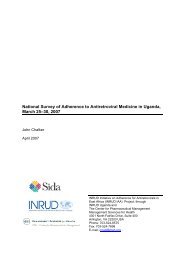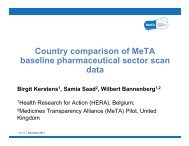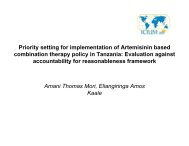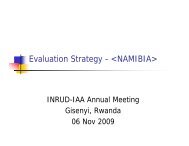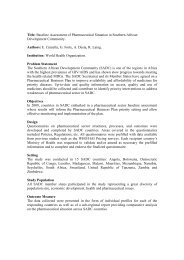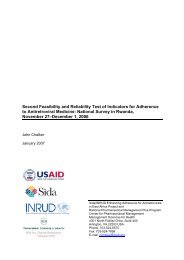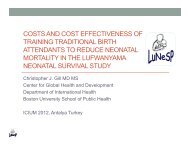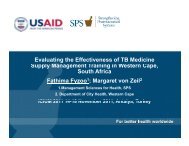How to investigate levels of Adherence to antiretroviral ... - INRUD
How to investigate levels of Adherence to antiretroviral ... - INRUD
How to investigate levels of Adherence to antiretroviral ... - INRUD
You also want an ePaper? Increase the reach of your titles
YUMPU automatically turns print PDFs into web optimized ePapers that Google loves.
<strong>How</strong> <strong>to</strong> Investigate <strong>Adherence</strong> <strong>to</strong> Antiretroviral Treatment:<br />
An Indica<strong>to</strong>r-Based Approach<br />
Using clinical records <strong>to</strong> measure this indica<strong>to</strong>r is possible only if the question has been asked<br />
consistently and recorded routinely. Because <strong>of</strong> this, self report written in clinical notes is a<br />
complementary adherence indica<strong>to</strong>r. In practice, clinicians or pharmacists may have asked<br />
patients about their adherence but not recorded the answer. Also, the recall period they may<br />
have asked about could vary between their adherence yesterday <strong>to</strong> their adherence since the<br />
last clinic visit.<br />
The indica<strong>to</strong>r chosen here using self-reporting is indica<strong>to</strong>r 1 below.<br />
Indica<strong>to</strong>r 1. Percentage <strong>of</strong> patients with full adherence <strong>to</strong> ART<br />
Rationale<br />
Source <strong>of</strong> data<br />
Data collection<br />
Perfect (or > 95%) adherence is the primary treatment goal.<br />
Patient self-report: ―In the last 3 days, have you missed any <strong>of</strong> the ARV<br />
doses you were supposed <strong>to</strong> take?‖ [Response: yes/no].<br />
Patient interview: Based on sample <strong>of</strong> 30 patients attending on day <strong>of</strong> data<br />
collection (or all patients if < 30 attend that day).<br />
Computation (Number <strong>of</strong> patients responding ―no‖/number <strong>of</strong> patients asked) × 100.<br />
Comments<br />
The question is standardized <strong>to</strong> 3 days. In practice this question could be<br />
asked for last 1, 2, 3, 4, or 7 days. For any <strong>of</strong> these periods, missing one<br />
dose is equivalent <strong>to</strong> less than 95% adherence (missing 1 dose in 7 days is<br />
7.1% <strong>of</strong> doses on a twice daily regimen). Calculation can be the same if the<br />
question is asked for 30 days or for the period since the last clinic visit, but<br />
interpretation would differ.<br />
Pitfalls<br />
The only hope <strong>of</strong> getting an honest answer is if the interviewer is friendly and<br />
non-<strong>of</strong>ficious. Interviewers need <strong>to</strong> be trained <strong>to</strong> ask the question in a<br />
uniform way.<br />
An example <strong>of</strong> use may be that, <strong>of</strong> 30 patients asked this question, four said that they had<br />
missed one or more doses in the last three days. This means that for this facility the selfreported<br />
full adherence rate would be 26/30 which is 86.7%. In practice the percentage is<br />
high and inflated (95% on average in the four field tests) but does correspond <strong>to</strong> clinical<br />
outcomes where it has been checked. The lowest percentage for a single facility in the four<br />
feasibility studies was 60%. So managers would know <strong>to</strong> concentrate their attention on that<br />
facility.<br />
Dispensing-based adherence measures<br />
Pharmacy dispensing records are useful <strong>to</strong> measure longer-term adherence patterns. By<br />
counting the number <strong>of</strong> days that medication is dispensed over a period, two important<br />
adherence indica<strong>to</strong>rs can be calculated—long-term adherence <strong>to</strong> ARVs and the rate <strong>of</strong><br />
patients with significant gaps in treatment.<br />
The dispensing-based adherence measures are defined as follows:<br />
1. Average percentage <strong>of</strong> days covered by ARVs dispensed for a sample <strong>of</strong> patients for<br />
a defined period (180 days).<br />
2. Percentage <strong>of</strong> patients who experienced a gap in ARV availability <strong>of</strong> more than 30<br />
days in a row during the same defined period.<br />
10



